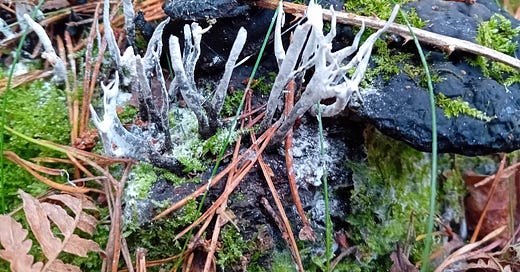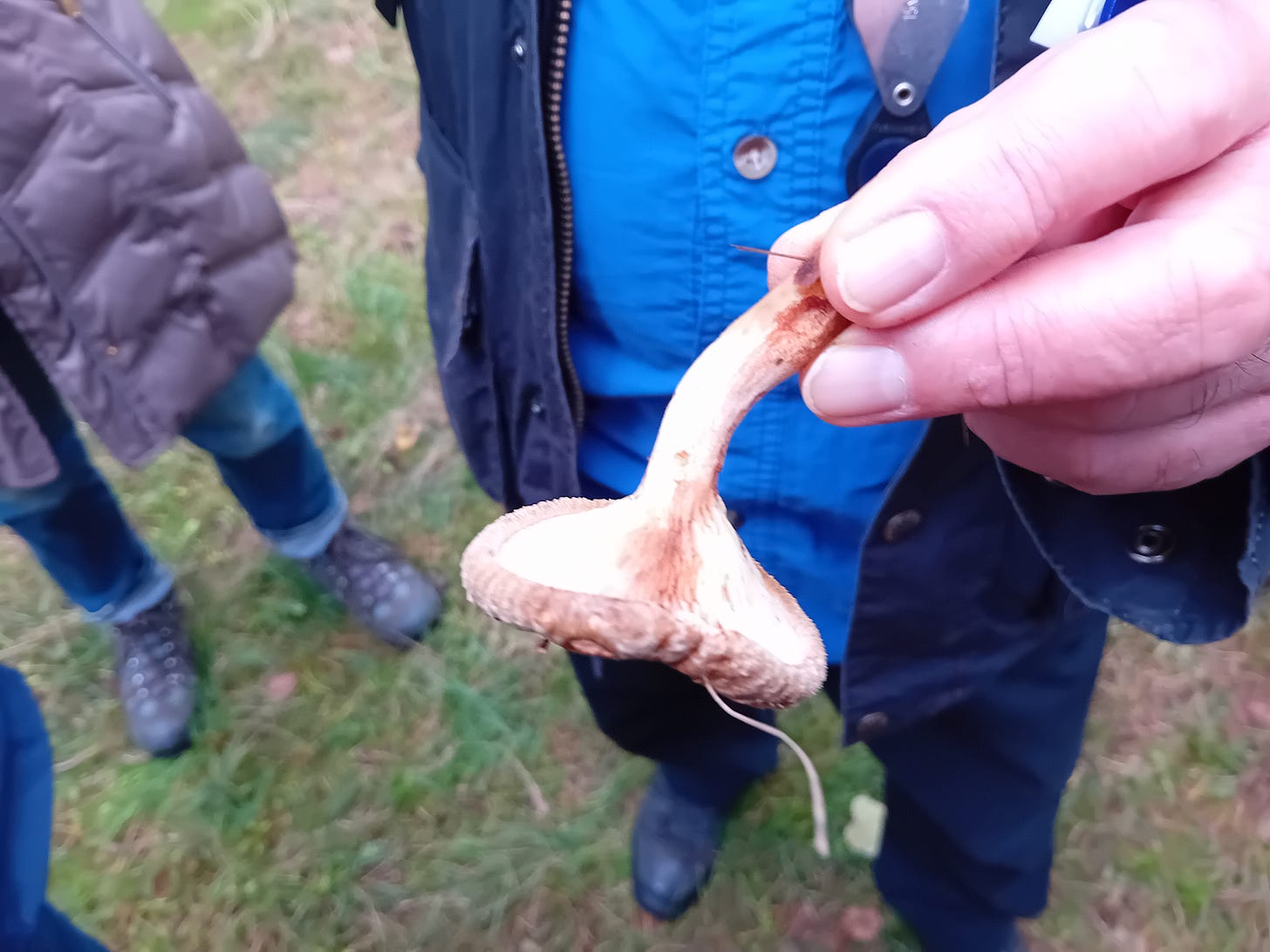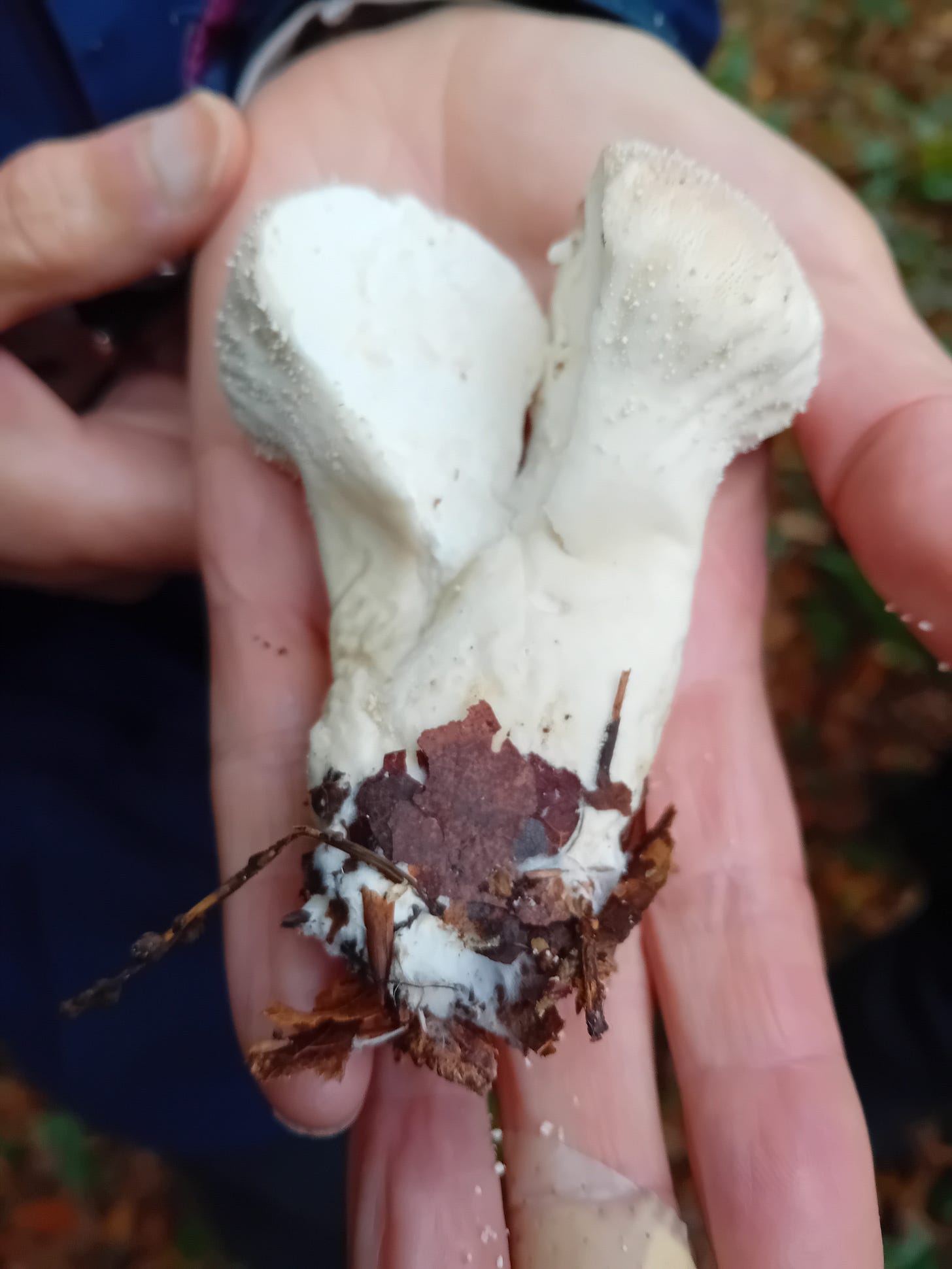The Wonderful World of Fungi
On discovering lots of fungi at Addington Hills, and some of the many benefits fungi provide

With the expert help of Clifford, the mycologist, the fungi are easy to spot, and we bring him one specimen after another to identify. He tells us not only the names but lots of other fascinating details and my head is soon reeling from all the information. We’re at Addington Hills and I’d never realised before how many fungi there are here, hidden among the leaf litter or sheltering under the brambles as well as those more easily seen in the grassy areas. And, of course, what we’re seeing are just the fruiting parts of organisms which are mostly hidden from view under the soil or the bark of trees. The list Clifford sends afterwards includes 28 different species mostly with just their Latin names.
We talk about the difference between mycorrhizal fungi which have symbiotic relationships with plants which benefit both plant and fungus for example through the sharing of nutrients, and saprotrophic fungi which feed on dead and decaying wood and leaf litter and play a vital role in the decomposition process, ensuring that nutrients are recycled back into the environment. We learn too about the way in which fungi reproduce by producing spores and how mycologists use the colour of those spores, as well as other characteristics, to identify species.
There are lots of other new terms to learn too - hygrophanous refers to the way in which the mushroom tissue changes colour as its ages (a process which makes the complicated task of fungi identification even harder); and an umbo is the raised area in the centre of the mushroom cap.
One of the species we see most of today has a distinct umbo and is what we soon learn is called a Butter Cap (Collybia butyracea) – so called because the top of the mushroom feels a little like butter to the touch. They certainly do have a slightly damp, slimy feel. There are also beautiful purple Amethyst Deceivers (Laccaria amethystea) and the less distinctive Common Deceivers (Laccaria laccata), some bright red Wax Caps (Hygrocybe miniata), small orange False Chanterelles (Hygrophoropsis aurantiaca) and a couple of scaly Common Earthballs (Scleroderma citrinum) their interior filled with dark brown spores.
Then there is the Brown Roll-Rim (Paxillus involutus) whose name comes from the fact that the gills roll over and on to the edge of the cap. In the younger specimen we find later this feature makes it looks as though the cap is decorated with a frilly collar or ruff. The first Brown Roll-Rim we find is older and much bigger – one of the largest fungi we see – and it no longer has its ruff. It has a tobacco brown stem and a pale yellowy brown cap, the colour of cinder toffee. Clifford tells us that until around the time of the Second World War books would identify this as an edible mushroom, but it was then discovered that it is in fact a cumulative poisoner and people were dying as the toxics accumulated in their bodies. It is also apparently the only gilled mushroom whose gills can be peeled off, and Clifford demonstrates this by pushing them off with his finger.
There is inevitably lots of discussion about which fungi are good to eat. We find one called the Charcoal Burner (Russula cyanoxantha) which is apparently a good edible mushroom. Then towards the end of the walk we find a young Puffball (Calvatia excipuliformis), growing in the leaf litter. This has a thin skin covered in small spines and Clifford uses a special mushroom knife to cut it open, to reveal a soft spongy white interior, meaning this one is edible. As they age, Puffballs turn olive inside (at which point they are no longer edible) and then brown as they release their spores through a chimney-like opening.
When discussing the eating of fungi, we talk about the fact that it’s not just your identification skills you need to be confident about. You also need to consider where you’re gathering them as fungi absorb toxins from whatever they are growing on, so if there is any risk that the land is contaminated, there is a high chance the fungi will be too and then you’ll be consuming those toxins if you eat them. This puts me in mind of the Merlin Sheldrake book, Entangled Life, in which he highlights the many, and complex, ways in which fungi could contribute to tackling the environmental challenges our society faces, including by consuming the things we want to get rid of.
I do some research online when I get home and find that the use of fungi to clean up pollution – a process known as mycoremediation – is becoming increasingly common. Some forms of fungi have even been found to absorb radiation, offering the potential for them to be used to help clean up radioactive waste. In New Zealand scientists have developed fungal-based technology which can remove the pesticide, PCP, from contaminated soils and a US organisation is examining whether fungi could be used to reduce the negative impacts of toxic ash-runoff following extensive wildfires. Mycoremediation may also have a role to play in tackling the pressing problem of plastic pollution, as fungi could help break down phthalate esters (PEs), the group of chemicals that are widely used in plastics and packaging, and which can have harmful effects on both humans and wildlife.
There is also increasing recognition of the healing properties of fungi something which has long been recognised in traditional Asian medicine where they are used to treat conditions ranging from allergies to infertility. Researchers have now identified that some of the mushrooms commonly used in traditional medicine can be used to develop targeted treatments for cancer. Fungi are also being used to treat neurodegenerative diseases such as Parkinsons and Alzheimers and to alleviate the symptoms of diabetes.
Added to all this, there is now evidence available that mycorrhizal fungi have a vital role to play in helping tackle the climate crisis as they are responsible for storing more than a third of global carbon emissions below ground. And, of course, they are essential for biodiversity too. It seems they have some benefits beyond just the fact that some of them are good to eat.
I have mixed feelings about focusing too much on what other species can do for humans. We should also value fungi simply for the sheer variety of shapes, colours, smells and textures that exist among their thousands of species, and for all the things we don’t yet know about them. But it is pretty amazing to consider how much we, and all life on earth, depend on species that are often ignored or overlooked.
To finish….
…a few things I’d like to share:
The 3F Initiative: The Fungi Foundation, an NGO dedicated to fungi, is calling for “funga” to be recognised as the third F alongside flora and fauna and has gained the support of the UK and Chile governments who submitted a proposal on this to the recent COP16 meeting on the UN Convention on Biological Diversity (CBD). Recognitions as a separate realm in the CBD would give fungi greater environmental protection.
Recording bryophytes: Like fungi, bryophytes – mosses, liverworts and hornworts – play a vital role in biodiversity but are often overlooked. This is a lovely article about someone who is studying bryophytes and recording their presence in various places in London. It’s another great example of just how much wildlife you can find in even the most unexpected of places if you look closely enough.
National Tree Week: Described as the ‘UK’s largest tree celebration’, this year’s National Tree Week runs from 23 November to 1 December. There’s more information about it, including an interactive map of tree-related events, on The Tree Council’s website.






That's a great article, fungi are fascinating. Thanks also for the link to Cassandra Li's article about bryophytes, I became very interested in bryophytes while surveying the wildlife of Edinburgh's cemeteries a couple of years back.